Wood Rot Treatment: How to Identify and Treat It
By Dave KileOne of the biggest threats to your beautiful deck is rot. I’ve seen moisture seeping in and staying put in the vulnerable parts of a deck. Repeated exposure to moisture can create rotted timber. Let me give you some suggestions on protecting your deck from rot.
How To Identify and Treat Wood Rot
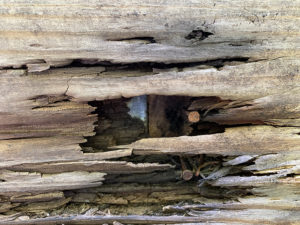 What does rot look like on affected timber? Check for dark or grey spots on your timber, warped or twisted timber, a musty smell, and soft areas. Over time, fungal rot can compromise your deck’s structural integrity. Therefore, it is essential to treat it quickly and effectively.
What does rot look like on affected timber? Check for dark or grey spots on your timber, warped or twisted timber, a musty smell, and soft areas. Over time, fungal rot can compromise your deck’s structural integrity. Therefore, it is essential to treat it quickly and effectively.
Both wet and dry rot have deleterious consequences and must be thwarted as soon as it’s spotted. The treatment for both types of rot is similar in that you would replace affected areas and stop any moisture seeping in. The treatment differs in the way of preventing the spread of timber decay. At Trex, we have many years of experience protecting from different types of rot fungus and moisture mitigation. Let’s explore the process of preserving your timber.
Types of Wood Rot
The two main types of wood or timber rot are wet and dry rot. Each is very detrimental and needs to be addressed as soon as possible to prevent further damage.
What is Wet Rot?
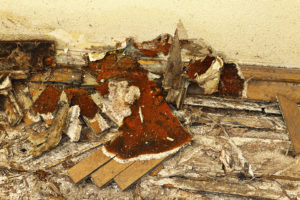
Wet rot, or corniophora puteana, is a fungal rot brought on by damp conditions. Moisture that seeps in from a leak or condensation can cause this. Moreover, constant water ingress and humidity play a part in furthering fungal growth.
You need to treat this type of rot at the source. Containing leaks, waterproofing, and using Trex Protect butyl tape are essential. If left untreated, wet rot weakens your deck and its substructure. Two main types of wet rot are brown rot and white rot.
Brown Rot
Brown rot, like the name, appears darker than the surrounding timber. Brown rot happens because mould fungus feeds on cellulose from other adjacent materials. This makes the affected timber look browner than normal.
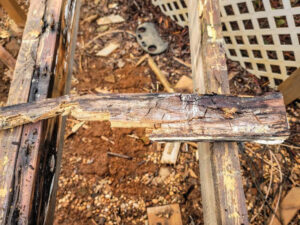 White Rot
White Rot
White rot occurs when fungal decay occurs in certain timber materials. The decay starts eating away at lignin, a natural binding polymer that helps timber stay rigid. The white rot, aptly named, is a white or greyish colour. It also feels crumbly when touched.
What is Dry Rot?
When most of us think about rot, we think of wet rot, not dry rot. Dry rot, or serpula lacrymans, can be much more devastating than wet rot.
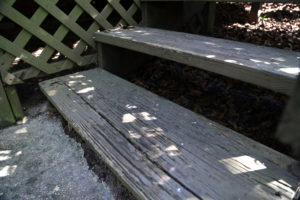 Dry rot is insidious and cyclical, consuming timber and other materials in four stages.
Dry rot is insidious and cyclical, consuming timber and other materials in four stages.
- Spores – dry rot begins its life cycle as spores in the air. When the air moisture content reaches around 20 per cent, then the spores are activated. They’ll attack timber or other wood materials.
- Hyphae – the spores adhere to the timber (or other food source) and expand, similar to a root system. These tendrils or roots might cause a dry cuboidal cracking appearance. The hyphae can extract moisture from the timber.
- Mycelium – as the hyphae grow, they combine to form mycelium. This wood-destroying fungus looks akin to cotton or wool. Mycelium then continues its infestation into new timber.
- Fruiting Body – once dry rot achieves its final stage; it can look similar to mushroom growth. During this stage, it produces dry rot spores (usually red), which once again return to being airborne, and the whole cycle starts over.
As you can see, dry rot is particularly difficult to eliminate. It’s more harmful than wet rot and can be harder to contain.
How to Stop Wood Rot
Now that we’ve distinguished the two primary forms of rot, how do we eradicate them? At Trex, we have been dealing with stopping fungus growth and fungal decay for a long time. We are pros at helping to keep your deck’s substructure free from timber rot. Although the methods to remedy wet and dry rot are comparable, wood rot treatment will vary slightly between the two types of rot.
Wet Wood Rot Treatment
The first step in treating wet rot is to find the source of moisture, discovering where water is leaking and containing that. Main areas of water leakage include window sills, condensation, plumbing issues, leaky gutters, and rising dampness. Fix these problems first and then use fungicide on the affected timbers. An important aspect to note is that painted timber might disguise areas damaged by wet rot.
In cases of widespread rot, you need to replace the decayed timbers. If this is the issue, it’s best to contact a rot specialist to assess the damage and help restore your timber. Additionally, a wet rot wood hardener can be applied to protect the timber.
Dry Wood Rot Treatment
Dry rot treatment is usually more extensive than treating wet rot. When dry rot happens, the mycelium works to infest more timber, thus causing further damage. Dry rot not only needs to be stopped at the point of fungal decay but also needs to be treated farther away from that point. We recommend about 50 cm past any damaged timbers.
After removing dry rot, use a wood preserver, such as Ronseal, to help protect your timber. This makes it more challenging for rot fungus to attack prone areas. Epoxy and wood filler can additionally help. It generally takes three factors for dry rot to occur. Moisture content in the atmosphere, along with poor ventilation, the ideal temperature (between 3° and 26° Celsius), and a food source all contribute to the proliferation of mould. Eventually, this will become rot.
Furthermore, dry rot affects the stability of timber. Once the timber has lost a small percentage of its weight, it can be affected by up to half of its strength! Therefore, inspecting floorboards and skirtboards for dry rot is crucial. Because of the atmospheric conditions that can create dry rot, attics and basements often are the perfect breeding ground.
The Cost to Treat Wood Rot
To reiterate, catching both forms of rot before they become a significant problem is essential. Inspecting your deck and surrounding areas, a dry rot survey, and being wary of any timber discolouration, soft spots, and musty smells will help alert you.
As for the breakdown of treating rot, it typically costs between £200 to £400 for a surveyor to come out. Removal of the damaged timber, treatment, and replacement can cost much more. If the rot spreads, the cost could be in the thousands. So, preventing rot conditions truly is key.
Wood Rot Prevention
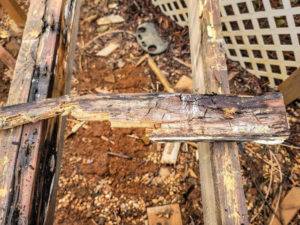 Let’s look at some ways to stop decay before a rot outbreak occurs. You can take several preventative measures that will avoid costly treatments.
Let’s look at some ways to stop decay before a rot outbreak occurs. You can take several preventative measures that will avoid costly treatments.
First, being aware of where fungi can grow is one of the best ways to start your inspection. Water seepage, leaks, and excess moisture in the air all lead to mouldy conditions. Rot takes hold – even with timber treated with wood preservatives.
Secondly, hire a professional to assess any potential problems. Start with waterproofing those areas. Trex Protect butyl tape is an excellent tool. Also, check underneath your timber substructure and damp proof any spots where water can linger.
Here are a few tips to help curb moisture:
- Seal cracks around doorways and windows with caulk
- Paint or putty areas around doorways and windows
- Consider covering an entryway with an awning or similar structure
- Remove any standing water from your deck
- Keep your gutters in good repair; address any leaks right away
Besides mitigating moisture and identifying any mildew problems, you can install a dehumidifier or an exhaust fan in basements, cellars, or attics. This will help pull excessive dampness out of the air. You want to keep the atmosphere dry, thus making it difficult for rot to feed on your timber.
There are plenty of resources to help protect your deck and other vulnerable areas from rot. Prevention of rot at its source is much easier than eradicating the problem once it takes hold.